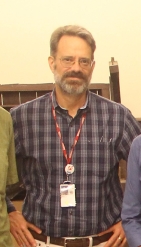
Michael Aday
Librarian-Archivist
National Park Service Collections Preservation Center Great Smoky Mountains National Park Townsend, Tennessee
michael_aday@partner.nps.gov
I have been the librarian-archivist at Great Smoky Mountains National Park in East Tennessee since October 2013. Though I am the archivist at a national park, I am not a federal employee. My salary is paid by the Great Smoky Mountains Association, one of the many partner organizations that support our national park system, however I report directly to the parks museum curator and am bound by the same guidelines that all federal employees must adhere to. I have a BA in historical studies from the University of Texas at Dallas and an MA in history with a concentration in archival administration from the University of Texas at Arlington. Before coming to the Smokies I was an archives technician at Yosemite National Park, a contract archivist at the Dallas Museum of Art, as well as a project archivist at Texas A&M University, Commerce.
In 2016 I was responsible for moving the parks archival collections, more than one million documents, into a newly constructed 4.5 million dollar purpose built storage facility, the National Park Service Collections Preservation Center located in Townsend, Tennessee. The facility came about as the result of a partnership between the federal government, the Great Smoky Mountains Association, The Friends of the Smokies, and the Great Smoky Mountains Heritage Center. The facility will eventually house the cultural collections for 5 regional national park units, including GSMNP, but the collections that I manage will be the only archival records to be stored in the new facility.

My work here primarily involves connecting with researchers, both from the park service and the general public. On average I process in excess of 275 research requests each year. Due to the nature of the parks creation in the 1930’s we have a large collection of records that are a treasure trove of information for genealogists, many of whom travel to the park for vacation and combine their visits with an opportunity to study their family history. In addition to the genealogy requests, I work with a large number of authors and academics. Park service employees researching various aspects of the parks history make up a smaller but no less important number of research requests.

The GSMNP archival collections span an extensive period of time. Our oldest record dates from the American Revolution and the most current records were accessioned in 2016. We have nearly 1700 LF of records including more than 20,000 historic photographs, in excess of 500 hours of oral history recordings and transcripts, a complete collection of the land transaction records that document the purchase of family holdings and commercial timber lands that formed the basis for the national park, as well as dozens of manuscript collections from many of the families that settled in this region of southern Appalachia after the American Revolution. As you might expect, the bulk of our collection consists of the records generated by Great Smoky Mountains National Park itself. From early press releases announcing the establishment of the park in 1926, to Historic American Building Survey records, superintendent reports, various division and branch records, as well as records detailing the recent celebration of the NPS centennial are all part of our collection of permanent records.


In 2010 the park worked with Clemson University on a digitization project that resulted in more than 14,000 of our historic photographs being made available on the Open Parks Network website. In 2015 we contracted with a company in Atlanta, Georgia to digitize our oral history recordings as well as hundreds of hours of park service training films and other visual media. Though not available online, these recordings are now accessible to researchers anywhere.
As a steward of public records I take my responsibility very seriously. I believe it is my responsibility to ensure that as few impediments as possible are placed between the American people and their access to this information. But records can’t be accessed if people don’t know they exist. To further that access I work diligently to educate the public about our holdings through presentations to local history and genealogy groups. In 2017 the museum curator and I gave tours of the new facility to more than 300 members of the public. Public outreach has the additional benefit of increased donations, both material and financial. As a result of increased public education about this new facility, we have received more than a dozen donations of materials that fall within our scope of collections and are poised to receive our first significant financial bequest. Increased public education and access can often be seen as a two-edged sword by some lone arrangers, but we have to overcome our fears of being inundated with traffic in order to raise the public profiles of our repositories. If people don’t access our holdings, how can we justify our existence?